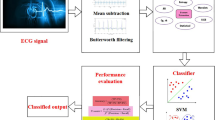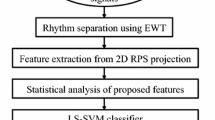Abstract
Arrhythmia is a unique type of heart disease which produces inefficient and irregular heartbeat. This is a cardiac disease which is diagnosed through electrocardiogram (ECG) procedure. Several studies have been focused on the speed and accuracy on the learning algorithm by applying pattern recognition, artificial intelligence in the classification algorithm. In this work a novel classification algorithm is planned based on ELM (Extreme Learning Machine) with Recurrent Neural Network (RNN) by using morphological filtering. The popular publicly available ECG arrhythmia database (MIT-BIH arrhythmia DB) is used to express the performance of the proposed algorithm where the level of accuracy is compared with the existing similar types of work. The comparative study shows that performance of our proposed model is much faster than the models working with RBFN (radial basis function network), BPBB(back propagation neural network) and Support Vector Machine. The experimental result with the MIT BIH database with hidden neurons of ELM with RNN, the accuracy is 96.41%, sensitivity 93.62% and specificity 92.66%. The classification methodology follows main four steps the heart beat detection, the ECG feature extraction, feature selection and the construction of the proposed classifier.






Similar content being viewed by others
References
Acharya UR, Fujita H, Oh SL, Hagiwara Y, Tan JH, Adam M (2017) Application of deep convolutional neural network for automated detection of myocardial infarction using ECG signals. Inf Sci 415:190–198
Andersen RS, Peimankar A (2019) A deep learning approach for real-time detection of atrial fibrillation. Expert Syst Appl 115:465–473
Anwar SM, Gul M, Majid M, Majdi A (2018) Arrhythmia Classification of ECG Signals Using Hybrid Features. Hindawi,Comput Math Methods Med. Article ID 1380348.
Atal DK, Singh M (2020) Arrhythmia classification with ECG signals based on the optimization-enabled deep convolutional neural network. Comput Methods Prog Biomed 196:105607
Chen T, Mazomenos EB, Maharatna K (2013) Design of a low-power on-body ECG classifier for remote cardiovascular monitoring systems. IEEE J Emerg Sel Top Circuits System 3(1):75–85
Duan L, Zhong H, Miao J, Yang Z, Ma W, Zhang X (2014) A voting optimized strategy based on ELM for improving classification of motor imagery BCI data. Cogn Comput 6(3):477–483
Ertam F, Avcı E (2017) A new approach for internet traffic classification: GA-WK-ELM. Measurement. 95:135–142
Fan X, Yao Q, Cai Y, Miao F, Sun F (2018) Multiscaled fusion of deep convolutional neural networks for screening atrial fibrillation from single lead short ECG recordings. IEEE J Biomed Health Inform 22(6):1744–1753
Huang GB, Zhu QY, Siew CK (2006) Extreme learning machine: a new learning scheme of feedforward neural networks. Neurocomputing. 70:489–501
Huang GB, Zhu QY, Siew CK (2006) Extreme learning machine: Theory and applications. International Joint Conference on Neural Networks. Budapest, Hungary. Neurocomputing 70:489–501
Jadhav SM, Sanjay L, Nalbalwar SL, Ghatol AA (2011) Modular neural network based arrhythmia classification system using ECG signal data. Int J Inform Technol Knowledge Manag 4(1):205–209
Jemilehin T, Adu M (2016) Design and simulation of electrocardiogram circuit with automatic analysis of ECG signal. Analele Univ. Eftimie Murgu, Resita 1:155–172
Kachuee M, Fazeli S (2018) Ecg heartbeat classification: a deep transferable representation. IEEE Int Conf Healthcare Inform. 443–444.
Kim J, Shin HS, Shin K, Lee M (2009) Robust algorithm for arrhythmia classification in ECG using extreme learning machine. Biomed Eng Online 8(31)
Kiranyaz S, Ince T, Gabbouj M (2016) Real-time patient-specific ECG classification by 1-D convolutional neural networks. IEEE Trans Biomed Eng 63(6):64–75
Kuila S, Dhanda N, Joardar S (2019) Feature Extraction and classification of MIT-BIH Arrhythmia Database. 2nd International Conference on Communication, Devices and Computing .Haldia Institute of Technology. Springer proceeding (LNEE). 602, pp. 417–427.
Li W (2019) Wavelets for electrocardiogram: overview and taxonomy. IEEE Access 7:25627–25649
Li C, Zheng C, Tai C (1995) Detection of ECG characteristic poin ts using wavelet transforms .IEEE. Trans Biomed Eng 42(1):21–28
Liang NY, Huang GB, Saratchandran P, Sundararajan N (2006) A fast and accurate online sequential learning algorithm for feedforward networks. IEEE Trans Neural Netw 17(6):1411–1423
Mar T, Zaunseder S, Martinez JP, Llamedo M, Poll R (2011) Optimization of ECG classification by means of feature selection. IEEE Trans Biomed Eng 58(8):2168–2177
Mark R, Moody G , MIT-BIH Arrhythmia Database [Online], [http://www.physionet.org/physiobank/database/mitdb/](n.d.)
Nurmaini S, Radiyati Umi P, Muhammad Naufal R, Gani A (2018) Cardiac arrhythmias classification using deep neural networks and principal component analysis algorithm. Int J Adv Soft Comput Appl 10(2):14–32
Oh SL, Ng EYK, Tan RS, Acharya UR (2019) Automated beat-wise arrhythmia diagnosis using modified U-net on extended electrocardiographic recordings with heterogeneous arrhythmia types. Comput Biol Med 105:92–101
Ortin S, Soriano MC, Pesquera L, Brunner D, San-Martin D, Fischer I, Mirasso CR, Gutierrez JM (2015) A unified framework for reservoir computing and extreme learning machines based on a single time-delayed neuron. Sci Report:5
Pandey SK, Janghel RR, Vani V (2020) Patient specific machine learning models for ECG signal classification. Procedia. Comp Sci 167:2181–2190
Prasad GK , Sahambi JS (2003) Classification of ECG arrhythmias using multi-resolution analysis and neural networks. Conference Proceedings. IEEE Converg Tech. .227–231.
Qin C, Schlemper J, Caballero J, Anthony NP, Joseph VH, Rueckert D (2019) Convolutional recurrent neural networks for dynamic MR image reconstruction. IEEE Trans Med Imaging 38(1):280–290
Rajpurkar P, Hannun AY, Haghpanahi M, Bourn C, Andrew Y. Ng. (2017) Cardiologist-level arrhythmia detection with convolutional neural networks. arXiv preprint arXiv: 1707.01836v1.
Saadatnejad S, Oveisi M, Hashemi M (2019) LSTM-based ECG classification for continuous monitoring on personal wearable devices. IEEE J Biomed Health Inform 24:515–523
Sarkaleh MK, Shahbahrami A (2021) Classification of ECG arrhythmias using discrete wavelet transform and neural networks. Int J Comp Sci, Eng Appl 2(1):1–13
Singh J, Kaur R (2016) Cardio vascular disease ClassificationEnsemble optimization using genetic algorithm and neural network. Indian J Sci Technol 9(SI):1–5
Yıldırım O, Plawiak P, Tan RS, Acharya UR (2018) Arrhythmia detection using deep convolutional neural network with long duration ECG signals. Comput Biol Med 102:411–420
Yu SN, Chou KT (2006) Combining independent component analysis and backpropagation neural network for ECG beat classification. Conference Proceedings. IEEE Eng Med Biol Soc. 3090–3093.
Zhang Y, Wang S, Xia H, Ge J (2009) A novel SVPWM modulation scheme. Applied power electronics conference and exposition. APEC 2009. Twenty-Fourth Ann IEEE. 128-131.
Zhang J, Xiao W, Li Y, Zhang S (2018) Residual compensation extreme learning machine for regression. ScienceDirect Neurocomputing 311:126–136
Zong W, Huang GB, Chen Y (2013) Weighted extreme learning machine for imbalance learning. Science direct. Neurocomputing. 101:229–242
Author information
Authors and Affiliations
Corresponding author
Ethics declarations
Conflict of interest
The authors declare that there is no conflict of interest in this research.
Additional information
Publisher’s note
Springer Nature remains neutral with regard to jurisdictional claims in published maps and institutional affiliations.
Rights and permissions
About this article
Cite this article
Kuila, S., Dhanda, N. & Joardar, S. ECG signal classification and arrhythmia detection using ELM-RNN. Multimed Tools Appl 81, 25233–25249 (2022). https://doi.org/10.1007/s11042-022-11957-6
Received:
Revised:
Accepted:
Published:
Issue Date:
DOI: https://doi.org/10.1007/s11042-022-11957-6




